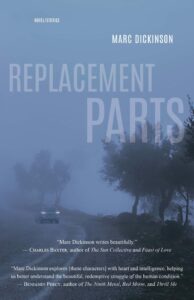
Marc Dickinson talks about his new book, Replacement Parts, and how it came together. Replacement Parts, a collection of linked short stories, is available now for purchase. Read the title story, featured in Volume 62.1 of Shenandoah, here.
Can you tell me the story of this book of stories: When did you start working on it? What were some of your preoccupations as you were writing it? When did you know you had a full collection on your hands?
The book began many years ago and went through many versions, but when I started to see similar plot points, themes, and conflicts, the collection soon came together—a lot of which emerged from the title, Replacement Parts, (which was the title from the story I published in Shenandoah).
Most of the stories in the books take place in small-town Iowa, focusing on the issues of working-class life—and its fight for survival—in modern America. So, Replacement Parts, of course, refers to blue-collar work, but on a larger level it hints at feeling ‘replaceable.’ To be part of working-class culture, it’s often easy to feel expendable.
Also, I was considering what we now call “generational trauma”—how cultural hardships and personal demons are passed down over time. So, the book follows three generations of a small town, each son and daughter inheriting the conflicts of their parents, creating a cycle that’s hard to break—as if the same lives are simply replacing the next. Still, the characters try to escape their history (as well as the town itself) but find it’s impossible to entirely outrun the past.
How would you describe your style or the literary tradition(s) you’re working in? It seems to be a book focused on place, or rooted in place. It’s also a linked collection of stories. I’ve seen it described as having both heart and intelligence, as being both intimate and novelistic. What descriptors feel right or most important to you? How do you position your work when you describe it, and what emotions do you hope most to invoke in readers?
In terms of style, it feels like the book straddles a few different traditions. In some ways, the book is literary in that it focuses on characterization, tries to push language, and attempts to risk the unexpected. However, I feel the writing itself, and the small-town setting, is also accessible to readers. So, though I hope the stories feel artfully crafted, I always aim for generosity when it comes to storytelling, letting emotion be first and foremost.
However, the overall structure is novelistic in that the stories are linked—and presented out of order. Each piece stands on its own, but if read from start to finish, the book follows several arcs over the course of years as characters dips in and out of each others’ lives.
Is there a passage you feel is a good representative of the book as a whole, or do you have a current favorite story? Can you describe a favorite moment or quote us a couple of lines?
Since it’s about the generation conflict, the narrators vary in age—elderly, middle-aged, teens/children. Maybe because I’m a father myself, I’m drawn to the younger voices. I admire their innocence and generosity, as well as their unique intelligence as they come of age.
One story that speaks to me features a group home for trouble teens that follows ten different points of view. There’s also a story about a young boy who lives next door to a girl with cancer–to watch their relationship grow and struggle was very personal.
But it’s the first story, which was published in Shenandoah, that set the stage for the book. Its teenage protagonist, Hannah, is the heart of the collection—her stories both begin and end the collection. We first meet her after she’s lost her mother and is reconnecting with her estranged dad, who sometimes leaves for days at a time. At one point, he returns, saying he was trying to ‘find’ a new mom for her, to which Hannah thinks, “One mother had been enough. Another just felt like replacement parts.” When that line arrived, I knew I had the title for the story, the collection, and a phrase that captured the theme/tone of the book.
(If you didn’t address this in the previous!): The title story appeared in Shenandoah in Volume 62 Number 1 under editor R. T. Smith. What’s that story’s relationship to the collection, and what was it like working with Rod on it?
As mentioned, it was the original title story. In revision, we swapped this title with another piece, but the entire book’s foundation began with the story Rod published, establishing the rest of the linked stories. As for Rod, he was so kind and smart with his suggestions—small changes that were quite complex when it came to matters of reveals, authenticity, and details—radically helping to shape the story into something better. You could also tell he worked closely with his student editorial team, often highlighting their collaboration as opposed to his own, which of course says a lot about his generosity as a mentor as well as an editor.
I’m curious about some logistics: How did you come up with the title? How did you find a publisher? What was your relationship with your editor like? What about the cover art? (And those are some heavy-hitting blurbs!
Again, the title came from the story published in the pages of Shenandoah, which truly acted as a north star for the book. The manuscript was rejected by every contest for years, and I was about to go the self-publishing route, which came with two problems—either you do it on the cheap and the quality suffers, or you invest so much money in it, you never get out of the red.
A friend of mine suggested, before self-publishing, to try Atmosphere Press wherein you invest a bit into your own project, but they provide all the support of a professional publisher—and you keep almost all the profits. It’s been an amazing experience. The editorial staff has been insightful in terms of revision, proofing, and publicity, while also allowing me to have a lot of control in terms of final content, cover art, and design.
What do you have planned in terms of promotion or events when the book comes out?
Literary journals are where I started, as both a writer and editor, so getting their endorsement means everything to me. But, overall, I’ve been kind of wandering the wilderness in this stage of the process. I imagine a marketing person from a big publisher would tell me I’m doing it all wrong—but since my one goal is just to get it into readers’ hands, as well as to hopefully earn some respect from these “lit-minded” people, whom I respect, I’ve been focusing a lot on one-on-one correspondence.
Aside from a few readings and interviews, I’ve been doing a lot of emailing, where I mention the book but try to really listen and catch up with important people in my life who I may have lost touch. It’s been rewarding to go this personal route as I reconnect with my literary roots.
Anything special you’re working on now or next?
Short stories are my passion, though I’m trying some new things— for me—when it comes to style, structure, and injecting more humor into my work.
I’m also revising a novel based on three points of view, based on a family suffering loss. But it also has comic book museums, and mysterious letters, and Walt Whitman, and evangelical Christian high schools, and new-age retreats, and road trips, and Ouija board séances, and….in other words, it’s a bit of a crazy mess right now—but it’s also a fun work in progress.
